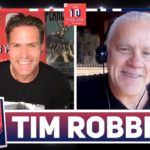BY THÉODEN JANES | JANUARY 22, 2020 06:00 AM
Tim Robbins, once one of Hollywood’s biggest names and now one of its most high-profile activists, doesn’t shy away from getting political.
In fact, just a month ago, the now-61-year-old “Bull Durham” and “The Shawshank Redemption” star stood on a stage at a Bernie Sanders campaign rally in Venice, Calif., and offered the Democratic presidential candidate his endorsement.
But while some theater critics have posited that a newly touring play he co-wrote and directs seems to be a not-so-thinly-veiled response to the current White House administration’s war on immigration, Robbins says he doesn’t view “The New Colossus” — which will settle into uptown’s Knight Theater next Tuesday through Sunday — as a political statement. At all.
“No, I view it as a celebration of what makes us what we are in this country,” Robbins says of the show, an ensemble piece featuring 12 diverse members of The Actors’ Gang Theater sharing deeply personal immigration stories that honor each of their real-life ancestors. “I view it as a human statement. A reminder that these are human beings. A reminder that the people that might not look like us now — that are seeking asylum here — are not coming to destroy us. They’re coming to add to our community.”
“The New Colossus” premiered at The Actors’ Gang Theater (a company in Culver City, Calif., co-founded by Robbins almost three decades ago) in February 2017, a product of workshopping that Robbins and his cohorts started during the Syrian refugee crisis. The play shares a title with the sonnet written by poet Emma Lazarus in 1883 for an exhibit to raise funds for the pedestal for the Statue of Liberty, which opened three years later and became a symbol of hope to anyone coming to the U.S. in search of a better life.
It’s worth noting that Robbins will be a part of the show — sort of; he’ll lead talkback sessions after six of the eight performances here in Charlotte, which is the first city on “The New Colossus’” first U.S. tour.
It’s also not a bad idea to read Lazarus’ sonnet for context before diving into the key excerpts from our recent chat with Robbins … but we’ll put it after the interview, so you can get right to it if you want.

The following has been lightly edited for clarity.
Q. So you say you started working on “The New Colossus” during the Syrian refugee crisis about three or four years ago. What did that look like?
At the time, there was a lot of talk in the media — kind of loose talk — about, you know, “We don’t want to be allowing refugees in because they’re potential terrorists,” right? It just seemed so out of whack with our principles — first of all, that we were considering women and children that were fleeing violence to be potential terrorists; but also in the nature of what we represent and who we are as a country. So we started talking amongst ourselves.
Meanwhile, I had a group of actors in the company for whom English is a second language, and in workshops, I had started telling them to — in improvisations — just speak in their own languages. The way that we work to access emotion — and then to go into the brain to translate it, and then to go back to the emotion — was a step that the people that spoke English didn’t need to take. So what happened was I saw these amazing actors start to emerge who had been struggling with English before.
And I asked the core of them to develop a piece based on their own history. Based on their own ancestors. Their relatives, that had come to America or had traveled from a violent area to freedom in seeking refuge. I asked these 12 actors to write their own stories, from their own families’ experiences.
The first time we did it, there was no English spoken at all. It was simply about a group of 12 disparate refugees from 12 different time periods, running away from a conflict and then winding up waiting for a boat. And what happened was it became a movement piece.
Q: What do you mean by that?
Well, it became a piece that relied on emotion, desperation, the struggle that people go through, but at the same time had this spirit of survival and humanity. And what we discovered in the course of developing the play was something that I hadn’t thought much about, and most people hadn’t thought much about, which is: What is the character of someone who would call themselves a citizen of this country?
I was left with nothing but admiration and awe of the incredible survival that happens when you leave a place that you consider your home. Because no one wants to leave their home voluntarily. Something forces these people out, in whatever generation we’re talking about, whether it’s the people on the Mayflower or it’s the people coming from war zones now.
Think about who survives. The DNA carrying on. We’re talking about an extraordinary DNA. We’re talking about people that not only have the foresight and the courage and the strength to leave an area of conflict — because a lot didn’t, and a lot died.
Not only do they have the strength and the character to leave, but the strength, perseverance and wherewithal to survive the journey away from this war zone. And then to get on a boat and survive that journey. And then to land somewhere new with absolutely nothing. And then survive and make a life, and raise a family. I mean, that’s a pretty extraordinary DNA. So I started thinking about what unites us. And it’s that. It’s that desire to risk everything to seek a better life. And I wanted to tell that story.

Q: I’m curious about the post-show talkback discussions you lead. I understand that the idea is to get audience members to share their own stories of immigration, or their ancestors’. I assume you’ve heard some interesting ones?
Oh, we’ve heard amazing stories after performances from our audiences. One was told by a woman who descended from a child that made the journey to America in the early 1900s — at 8 years old, with nothing but a picture of a relative. No address. A name and a picture. No address. Going into New York City, at 8 years old. Finds her community, and starts a life.
Another woman came up to me outside of our theater and told me a story about an American soldier:
He was one of the American troops that were liberating Buchenwald, the concentration camp. This soldier saw this woman — one of the people that had been starving to death — and she started to falter. So the soldier started to run towards this woman to catch her before she fell. His sergeant ordered him to stand down, saying this isn’t what he’s supposed to be doing right now. But he disobeyed his sergeant, caught the woman before she fell, and carried her to the medic. He got in trouble but found a way to visit her as she was recovering.
This woman, outside our theater, then told me, “That was my mother and my father.”
There’s amazing stories. Hundreds, thousands of stories out there. That’s part of the reason I’m really excited about touring, to hear these stories. To tell our story, but then to hear the stories of our audience. I find it deeply inspiring and unifying. I think it’s something we need to do a lot more in this country: Find ways to tell stories that unify.
EMMA LAZARUS’ ‘THE NEW COLOSSUS’
Not like the brazen giant of Greek fame,
With conquering limbs astride from land to land;
Here at our sea-washed, sunset gates shall stand
A mighty woman with a torch, whose flame
Is the imprisoned lightning, and her name
Mother of Exiles. From her beacon-hand
Glows world-wide welcome; her mild eyes command
The air-bridged harbor that twin cities frame.
“Keep, ancient lands, your storied pomp!” cries she
With silent lips. “Give me your tired, your poor,
Your huddled masses yearning to breathe free,
The wretched refuse of your teeming shore.
Send these, the homeless, tempest-tost to me,
I lift my lamp beside the golden door!”

TIM ROBBINS’ ‘THE NEW COLOSSUS’
When: 7:30 p.m. Jan. 28-30; 8 p.m. Jan. 31; 2 and 8 p.m. Feb. 1; and 1:30 and 7 p.m. Feb. 2. (Audio description will be provided for the 1:30 p.m. show on Feb. 2; Robbins will not host post-show talkbacks on Sunday.)
Where: Knight Theater, 130 S. Tryon St.
Tickets: $20 and up.
Details: 704-372-1000; www.carolinatix.org.


